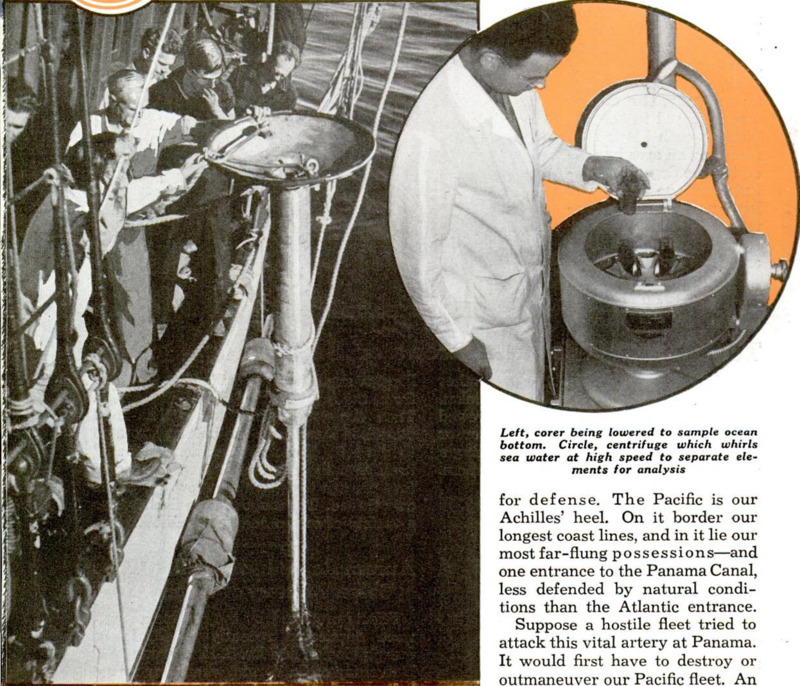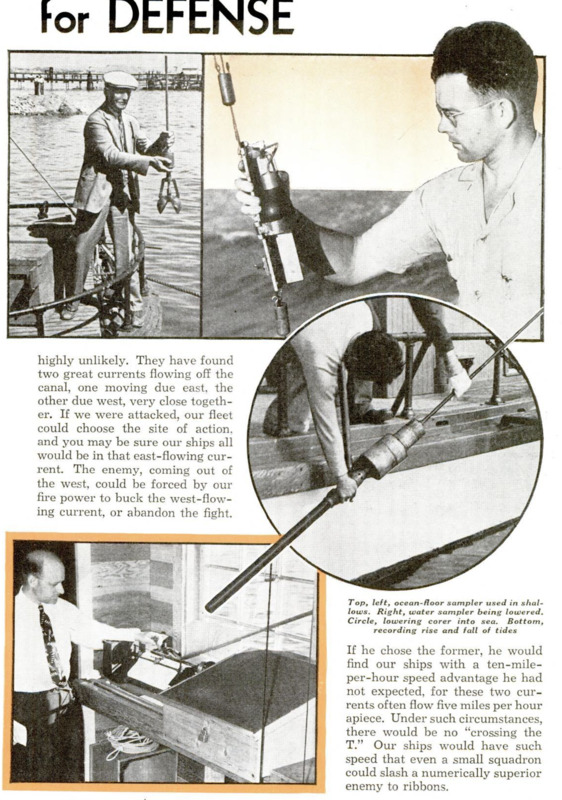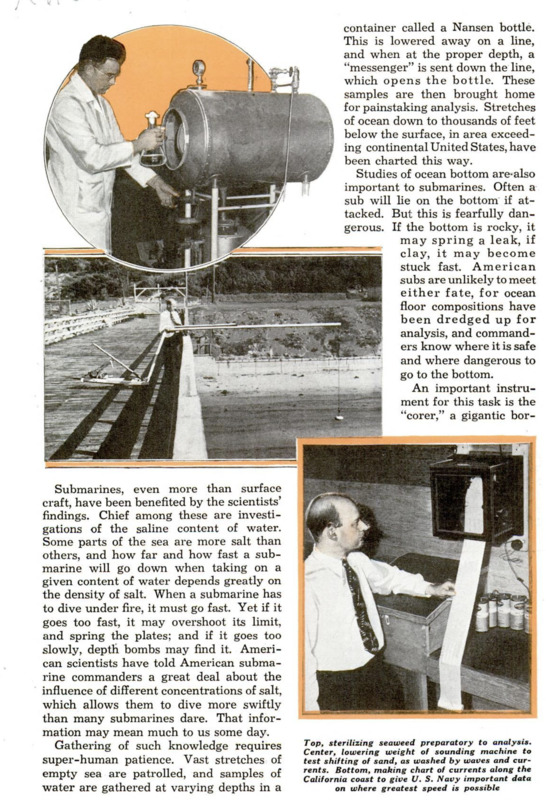CRUISING in the Pacific is a tiny craft that our most obsolete warship could blow out of the water. Yet in some future naval battle, that little craft may have more influence on the outcome than a squadron of powerful battle-wagons. For aboard this ship are scientific men who have been quietly charting the ocean, until our navy knows more about the waters it defends than any other navy in the world. This craft is the “Scripps,” of the Scripps Institufe of oceanography in LaJolla, Calif., and it is carrying science down to the sea for defense. The Pacific is our Achilles’ heel. On it border our longest coast lines, and in it lie our most far-flung possessions - and one entrance to the Panama Canal, less defended by natural conditions than the Atlantic entrance. Suppose a hostile fleet tried to attack this vital artery at Panama. It would first have to destroy or outmaneuver our Pacific fleet. An excellent strategy would be “crossing the T.” That is, the enemy steaming out of the west would try to out-run and out-gun our ships, so that a turn could be made in front of them. This not only would put the enemy between the U. S. Navy and the canal, but it would bring the fire of all enemy ships on the first ship in our line, while the remainder trailed out of range, only to be blown to bits as they came up one by one. Since American ships are admittedly heavier armed, and therefore slower than many other ships, this looks possible. But findings of the ocean scientists render it highly unlikely. They have found two great currents flowing off the canal, one moving due cast, the other due west, very close together. If we were attacked, our fleet could choose the site of action and you may be sure our ships all would be in that east-flowing current. The enemy, coming out of the west, could be forced by our fire power to buck the west-flowing current, or abandon the fight. If he chose the former, he would find our ships with a ten-mile-per-hour speed advantage he had not expected, for these two currents often flow five miles per hour apiece. Under such circumstances, there would be no “crossing the T.” Our ships would have such speed that even a small squadron could slash a numerically superior enemy to ribbons. Submarines, even more than surface craft, have been benefited by the scientists’ findings. Chief among these are investigations of the saline content of water. Some parts of the sea are more salt than others, and how far and how fast a submarine will go down when taking on a given content of water depends greatly on the density of salt. When a submarine has to dive under fire, it must go fast. Yet if it goes too fast, it may overshoot its limit, and spring the plates; and if it goes too slowly, depth bombs may find it. American scientists have told American submarine commanders a great deal about the influence of different concentrations of salt, which allows them to dive more swiftly than many submarines dare. That information may mean much to us some day. Gathering of such knowledge requires super-human patience. Vast stretches of empty sea are patrolled, and samples of water are gathered at varying depths in a container called a Nansen bottle. This is lowered away on a line, and when at the proper depth, a “messenger” is sent down the line, which opens the bottle. These samples are then brought home for painstaking analysis. Stretches of ocean down to thousands of feet below the surface, in area exceeding continental United States, have been charted this way. Studies of ocean bottom are-also important to submarines. Often a sub will lie on the bottom if attacked. But this is fearfully dangerous. If the bottom is rocky, it may spring a leak, if clay, it may become stuck fast. American subs are unlikely to meet either fate, for ocean floor compositions have been dredged up for analysis, and commanders know where it is safe and where dangerous to go to the bottom. An important instrument for this task is the “corer,” a gigantic boring machine which obtains samples for analysis; another is the Ekman ocean floor sampler, a miniature “orange peel” like those used on certain dredges. Topographic studies of the ocean also have immense value to submarines, There is little likelihood that undersea craft will, crash into shoals, even in uncharted regions, for sonic depth finders warn against. them. But if the topography is known, the submarine may use these same depth finders ta navigate without ever coming to the surface. Much Pacific topography is now well enough known for this. What of naval aviation? It, too, has come in for large benefits, particularly in weather and weather forecasting. For instance, it is known that a high fog bank often extends off the California coast for as much as seventy miles. Then it clears for thirty or forty miles, and there is another which may extend two hundred miles. These banks would make excellent ambush spots or refuges for Uncle Sam’s war birds, if they were lying in wait for an unwary foe, or seeking shelter from superior numbers. It is highly important that we know when and where to find such banks, for in the air, hiding places are few and far between. Naval aviation has also learned from American scientists where to get the best tail winds. On a long hop above the Pacific, they would alternate many times between flying high and low for tail winds. With our knowledge of air currents, even cumbersome bombers could often escape the fleetest pursuit ships. Compiling this information has involved exhausting work. Hydrogen-filled balloons have been released by the thousand and watched to see where the wind carried them. Now we know; and some day the knowledge may be worth more than all the gold we have buried. What about oceanic life - does it have any relationship to our defense? Indeed it does. There probably have been as many naval battles won or lost by barnacles as by bullets. These heavy growths attach themselves to the bottoms of ships and the pontoons of planes, causing enormous losses in efficiency. It has been estimated that in as little as a week, enough marine growths can get on pontoons to reduce speed twenty-five per cent. Here again science has aided our defense. It is known that Scripps, in cooperation with the navy, has developed a paint which repels marine organisms. It is a strict naval secret – but we know it exists. But all marine life is not a nuisance. Todine is as important to a modern army as food, and almost all of it comes from kelp. Too, in the last war, people were urged to eat more fish, since they require no feeding and care. Indeed, there are countless uses for marine life that help us defend ourselves, and findings at Scripps make its exploitation more efficient. They are doing much to protect our marine life, both plant and animal. Heretofore, we often have been puzzled when a species of fish disappeared. Now we know it is usually due to disappearance of some other sea creature first, possibly a microscopic one, on which the larger fish depended for food or protection against enemies. At Scripps, they have done great amounts of work to keep the balance of life in the ocean steady. It is a far more delicate balance than we have on land, and a slight shift in it may upset everything. If this happened in time of war, when food was scarce and we were ringed by enemies, the result might well be fatal. But have little fear. Science has rendered such a catastrophe unlikely. It is striking to note that while we have been letting our armaments decline, and now have to rearm with feverish haste, science has been going ahead quietly in its own way to close the gaps in our ramparts.






